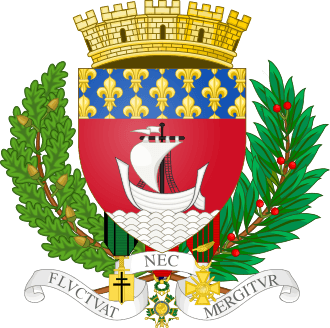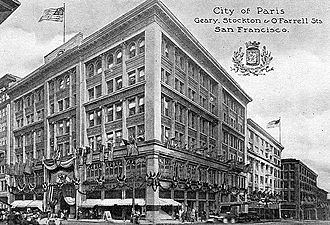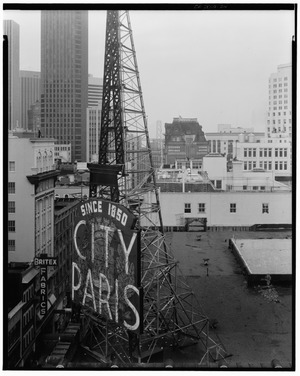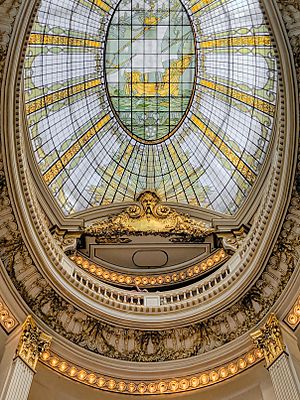City of Paris Dry Goods Co. facts for kids
Quick facts for kids City of Paris Dry Goods Company |
|
|---|---|

Motto of the City of Paris
|
|

The building in 1909
|
|
| Alternative names | City of Paris |
| General information | |
| Status | Demolished 1980 |
| Type | department store |
| Architectural style | Beaux-Arts |
| Address | 150 Stockton Street |
| Town or city | San Francisco, California |
| Country | United States |
| Coordinates | 37°47′15″N 122°24′23″W / 37.787432°N 122.406464°W |
| Opened | 1896 |
| Closed | 1981 |
| Design and construction | |
| Architect | Clinton Day |
| NRHP reference No. | 75000471 |
| Added to NRHP | January 23, 1975 |
The City of Paris Dry Goods Company was a very important department store in San Francisco. It operated from 1850 to 1976. The main store was right across from Union Square. Later, it opened other stores around the Bay Area.
The main San Francisco store was torn down in 1980. People tried hard to save it. A new Neiman Marcus store was built there. But the old store's beautiful rotunda and glass dome were saved. They became part of the new building.
Contents
How the City of Paris Store Started
The store's story began during the California Gold Rush in 1849. Two brothers, Felix and Emile Verdier, started the company in May 1850. Emile arrived in San Francisco Harbor on a ship called the Ville de Paris (City of Paris).
The ship was full of fancy goods like silks, laces, fine wines, and champagne. People in San Francisco quickly surrounded the ship in rowboats. They bought everything without it even being unloaded! Many paid with bags of gold dust.
Emile Verdier went back to France and loaded another ship. He returned to San Francisco in 1851. He opened a small store by the water at 152 Kearney Street. He named it the City of Paris. The store's motto was Fluctuat nec mergitur. This is Latin for "It floats and never sinks." It was taken from the city seal of Paris, France.
The store's most famous building was finished in 1896. It was designed by architect Clinton Day. This beautiful building was located at Geary and Stockton streets. It was directly across from Union Square.
Other Stores and Connections
The City of Paris store also had branches in other cities. A branch opened in San Diego in 1886. It was in the Bancroft Building. This building was also designed by Clinton Day.
In the 1940s, more City of Paris stores opened. These were in places like Vallejo, California, and other towns in the Bay Area.
A French immigrant named Auguste Fusenot became a partner in the City of Paris company. He later started his own department store in Los Angeles in 1893. It was called the Ville de Paris.
Surviving the San Francisco Earthquake
The City of Paris building was one of the few that survived the 1906 San Francisco earthquake. It also survived the huge firestorm that followed. The inside of the store was badly damaged by fire, though.
After the earthquake, the inside was redesigned. It got a grand central rotunda with a beautiful stained glass dome. The store reopened in 1909.
In 1909, the store started a special tradition. They placed a huge Christmas tree in the center of the rotunda. This tree became known as San Francisco's official Christmas tree.
The City of Paris always kept a strong link to French culture. This was seen in the store's decorations and what they sold. They had a huge wine department with many fine French wines.
During the time of Prohibition, when alcohol was banned, the lower level of the store was changed. It was made to look like a French village and called Normandy Lane. Even Macy's across the street copied this idea.
In 1961, famous chef Julia Child visited the store. She and Simone Beck gave cooking demonstrations. They were promoting their new cookbook, Mastering the Art of French Cooking. The bookstore Brentano's also had a branch inside the City of Paris. It became the biggest bookstore west of Denver.
The Store Closes Down
The Verdier family owned and managed the City of Paris until it closed in March 1972. The store was not out of money, but it was losing some.
A company called Liberty House bought the building. They reopened it as Liberty House at the City of Paris. Liberty House later built a new store nearby. They closed the old City of Paris building in 1974.
The site was then sold to Neiman Marcus. Neiman Marcus wanted to tear down the old building. They planned to build their own large department store there. This started a long fight to save the old building.
Even though the building was listed as a historic place, it was torn down in 1981. Many people signed petitions to save it. The new building was designed by architect Philip Johnson.
The most important part of the new building is the original rotunda and stained glass skylight. They were saved and moved to a corner of the building. This corner faces Union Square. The old rotunda is now inside a modern glass wall. There is a restaurant on the top floor around it.



